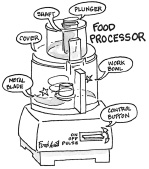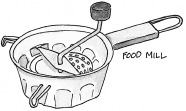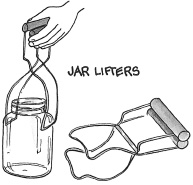Canning and Preserving For Dummies (5 page)
Read Canning and Preserving For Dummies Online
Authors: Amelia Jeanroy

The following items aren’t absolutely mandatory, but they’re certainly nice to have. If you don’t already have these items in your kitchen, add them as you find the need for them. They don’t take up a lot of room, and you’ll find yourself constantly reaching for them when you can.
Vegetable peeler:
Use this for peeling carrots, potatoes, and apples.
Potato masher:
This makes quick work of smashing your cooked fruits or vegetables.
Lemon juicer (refer to Figure 2-2):
This tool works on any citrus fruit and allows you to extract the juice in a hurry. Just cut your fruit in half, insert the juicer point into the fruit, and press away.
 Measure your juice and keep seeds and pulp out at the same time by squeezing your fruit into a mesh strainer resting on the edge of a measuring cup.
Measure your juice and keep seeds and pulp out at the same time by squeezing your fruit into a mesh strainer resting on the edge of a measuring cup.
Melon baller:
With
a melon baller, you can easily remove the seeds from a halved cucumber without having the seeds end up all over your kitchen.
Corer:
This tool removes apple cores without damaging the fruit. This is a real timesaver when you’re handling pounds of apples.
Cherry/olive pitter:
There’s nothing better for removing cherry and olive pits. Purchase the size of pitter that holds your fruit size.
Pots, pans, mixing bowls, and more
You probably already have an assortment of pots, pans, and mixing bowls. If not, don’t worry: You don’t need to purchase everything at one time. Start with a good basic assortment and add pieces as you find a need for them.
Pots:
Pots have two looped handles (one on each side of the pot), range in size from 5 to 8 quarts, are deep, and allow ample space for the expansion of your food during a hard-rolling boil. A good-quality, heavy-bottomed pot provides even heat distribution for cooking jams, jellies, or other condiments.
Saucepans:
Saucepans range in size from 1 to 3 quarts. They have a long handle on one side of the pan and usually come with a fitted lid.
Mixing bowls:
Keep a variety of mixing bowl sizes in your kitchen. Look for sets in graduated sizes that stack inside each other for easy storage. Bowls made from glass and stainless steel are the most durable.
 Purchase mixing bowls with flat, not curved, bases. They won’t slide all over your kitchen counter while you work. When mixing vigorously, place a damp dishtowel under the bowl. This prevents the filled bowl from sliding.
Purchase mixing bowls with flat, not curved, bases. They won’t slide all over your kitchen counter while you work. When mixing vigorously, place a damp dishtowel under the bowl. This prevents the filled bowl from sliding.
Colander:
Colanders aren’t just for draining pasta. They’re perfect for washing and draining fruits and vegetables. Simply fill your colander with food and immerse it in a sink full of water. Remove the colander from the water and let your food drain while you move on to other tasks.
Wire basket:
A collapsible wire or mesh basket with a lifting handle makes blanching a breeze. Place your filled basket of food into your pot of boiling water. When the blanching time is up, lift the food-filled basket out of the boiling water.
Specialty equipment to make work easier
All the items in this list are indispensable for your canning chores. They all save you loads of time.
Food processor:
Purchase the best-quality food processor you can afford. It should be heavy and sturdy so that it doesn’t bounce around on your kitchen counter as it’s processing away. Figure 2-4 is one example of a food processor.
Food mill:
A food mill (see Figure 2-5) purées fruits and vegetables as it removes the peel and seeds. You accomplish this by manually cranking the blade, which forces the pulp through the mill. Look for a food mill that rests on the edge of your bowl or pot, which enables you to use one hand to stabilize the mill while you crank the blade with your other hand.
Figure 2-4:
A food processor.

Figure 2-5:
Food mill.

Blender:
A blender purées fruits and vegetables in a hurry, but you need to remove the peel and seeds first. Be cautious of incorporating too much air into your food.
Food scale:
A food scale is essential when your canning recipe lists your fruit or vegetables by weight. The two most common types of food scales are spring and electronic. Examples of these are shown in Figure 2-6.
 A food scale with metric quantity markings makes converting recipe ingredients a breeze.
A food scale with metric quantity markings makes converting recipe ingredients a breeze.
A
spring scale
(sometimes referred to as a manual scale) allows you to place a bowl on the scale and manually adjust the weight setting to 0 before weighing your food. After placing your food on the scale, read the indicator on the dial to determine the weight.
An
electronic scale
is battery operated with a digital readout. It’s more costly than a spring scale but easier to read. Look for one with a
tare feature.
This allows you to set the scale to 0 if you add a bowl to hold your food. If you have a choice, choose an electronic or digital scale.
Figure 2-6:
Two types of food scales: electronic and spring.

Vacuum-sealing machines:
A vacuum sealer is the most efficient appliance around for removing air from food-storage bags. Use vacuum sealers for packaging dried foods or for storing raw or cooked foods in the freezer. Although it takes up room and can be costly, you’ll realize its full value after you own one. New on the market are hand-held vacuum sealers. They can provide a less-expensive alternative to purchasing an electric version.
Canning Equipment
The equipment in this section is especially designed for canning, which means you’ll use it during canning season but not much otherwise. Make sure you store these items in a safe, clean location. And be sure to look over every piece each time you use it to check for wear and tear.
Canning vessels
The kind of food you’ll be canning determines the type of vessel you’ll be using: a water-bath canner or a pressure canner. Refer to Chapters 4 and 9, respectively, for detailed information on using each of these vessels.
Water-bath canner
A water-bath canner, also referred to as a boiling-water canner, is a kettle used for processing high-acid foods (primarily fruits, jams, jellies, condiments, and pickled foods). The canner consists of a large enamelware or stainless-steel pot with a tight-fitting lid and a jar rack. Check out Chapter 4 for an illustration of a water-bath canner and instructions on how to use one.
Pressure canner
A pressure canner, sometimes referred to as a steam-pressure canner, is used for canning low-acid foods (primarily vegetables, meats, fish, and poultry) in an airtight container at a specific pressure. A weighted gauge or a dial gauge measures steam pressure in the canner. This ensures that the high temperature of 240 degrees is attained to safely process your food. Pressure canners and how to use them are described (and illustrated) in Chapter 9.
Canning tools
These tools are must-haves for water-bath or pressure canning. Safety in the kitchen is number one, and the right tools for handling hot, filled jars and other large canning equipment are indispensable.
Jar lifter
A jar lifter is one tool you don’t want to be without. It’s the best tool available for transferring hot canning jars into and out of your canning kettle or pressure canner. This odd-looking, rubberized, tonglike item (check out Figure 2-7) grabs the jar around the
neck
(the area just below the threaded portion at the top of the jar) without disturbing the screw band.
Figure 2-7:
Jar lifters.
